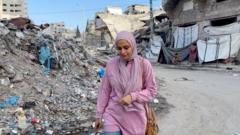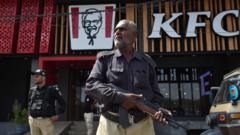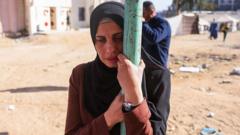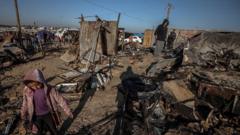Israeli Defense Minister Israel Katz announced that Israeli troops will continue to occupy areas within Gaza, dubbed "security zones," even following the conclusion of the ongoing armed conflict. This decision comes amid a backdrop of increasing violence, with recent strikes resulting in significant Palestinian casualties.
Israeli Defense Minister: Troops to Maintain Presence in Gaza After Conflict
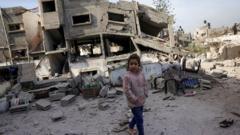
Israeli Defense Minister: Troops to Maintain Presence in Gaza After Conflict
Israeli Minister Katz confirms ongoing military presence in Gaza, citing security and humanitarian concerns amid escalating violence.
In a recent statement, Katz emphasized that these zones are intended to serve as a protective buffer for Israeli communities. He indicated that substantial portions of Palestinian territory have been integrated into these zones since hostilities reignited three weeks ago, with no plans for troop withdrawal. He stated that Israel's policy will involve maintaining a blockade on humanitarian aid as leverage to press Hamas for the release of hostages.
Recent reports from hospitals in Gaza highlight the severe humanitarian crisis, with over 1,650 Palestinians reportedly killed since the conflict escalated again on March 18. Amidst this violence, Katz noted that the Israel Defense Forces (IDF) has undertaken operations targeting what they term "terrorist infrastructure."
As casualties mount, including children and families, humanitarian organizations like Médecins Sans Frontières continue to raise alarms about the deteriorating conditions for those trapped in Gaza. The comprehensive blockade and ongoing military operations compound the challenges faced by displaced Palestinians.
On the diplomatic front, Hamas has rejected an Israeli ceasefire proposal and maintains communication struggles with the U.S. and Israeli officials regarding the fate of hostages. The conflict has resulted in the displacement of around 500,000 people, exacerbating the region's dire situation as calls for humanitarian access are stifled amidst military engagement.
The military operations were initially triggered by a cross-border attack by Hamas on October 7, 2023, leading to significant casualties and the taking of hostages. Now, as Israeli forces aim to reassert control, the humanitarian landscape in Gaza worsens, prompting urgent calls for aid and a reassessment of the ongoing strategies employed by both sides in this long-standing conflict.
Recent reports from hospitals in Gaza highlight the severe humanitarian crisis, with over 1,650 Palestinians reportedly killed since the conflict escalated again on March 18. Amidst this violence, Katz noted that the Israel Defense Forces (IDF) has undertaken operations targeting what they term "terrorist infrastructure."
As casualties mount, including children and families, humanitarian organizations like Médecins Sans Frontières continue to raise alarms about the deteriorating conditions for those trapped in Gaza. The comprehensive blockade and ongoing military operations compound the challenges faced by displaced Palestinians.
On the diplomatic front, Hamas has rejected an Israeli ceasefire proposal and maintains communication struggles with the U.S. and Israeli officials regarding the fate of hostages. The conflict has resulted in the displacement of around 500,000 people, exacerbating the region's dire situation as calls for humanitarian access are stifled amidst military engagement.
The military operations were initially triggered by a cross-border attack by Hamas on October 7, 2023, leading to significant casualties and the taking of hostages. Now, as Israeli forces aim to reassert control, the humanitarian landscape in Gaza worsens, prompting urgent calls for aid and a reassessment of the ongoing strategies employed by both sides in this long-standing conflict.


